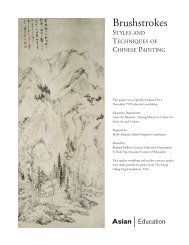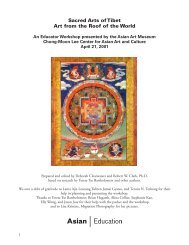Download PDF - Asian Art Museum | Education
Download PDF - Asian Art Museum | Education
Download PDF - Asian Art Museum | Education
Create successful ePaper yourself
Turn your PDF publications into a flip-book with our unique Google optimized e-Paper software.
Activity/Discussion<br />
1) Seasonal Signals.<br />
Ask students to examine the plant life and see if they can identify when the two scenes<br />
(top and bottom) took place. Hint: brown grasses and red-tinged maple symbolize<br />
autumn, plum blossoms early spring. Chapter 30 takes place in autumn, Chapter 51<br />
takes place in late-winter/early spring.<br />
2) How is pictorial space treated?<br />
Ask students to examine this painting and discuss the way it is organized. How has the<br />
artist separated the three scenes? (clouds divide top from bottom; bridge divides top<br />
right from top left). Where has the artist situated us, the viewers? (we are above looking<br />
down) Japanese artists cleverly maximized their painting space. By bringing the viewer<br />
up higher/tilting the ground, they had more space to depict the story. Subtle devices like<br />
clouds give the viewer visual clues about where one scene ends and another begins.<br />
Source:<br />
Shikibu, Murasaki. The Tale of Genji. Translated by Edward G. Seidensticker. New York:<br />
Alfred A. Knopf, 1977.<br />
<strong>Asian</strong> <strong>Art</strong> <strong>Museum</strong> <strong>Education</strong> Department
















